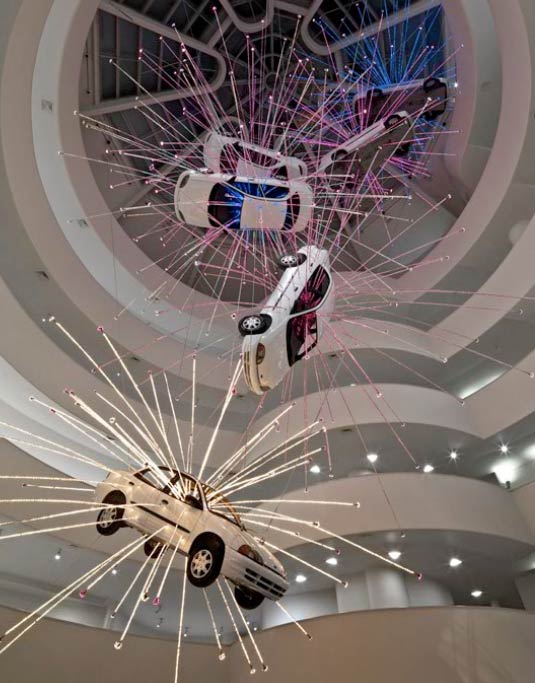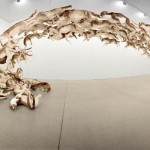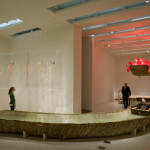When I went to the Cai Guo-Qiang exhibit I Want to Believe at the Guggenheim I thought I knew what kind of experience to expect. After having seen his work at MASS MoCA and the MET, I expected the museum to be filled with large-scale projects that overwhelm the viewer with the complexity of how they were executed. I was not disappointed, as you enter the museum you are immediately thunderstruck (no better word could be used) by the installation of the piece Inopportune: Stage One, nine cars suspended and spiraling up the center of the rotunda with lights exploding out of them.
Thomas Krens, Director of the Solomon R. Guggenheim Foundation, described the piece as "maybe the best artistic transformation of the Frank Lloyd Wright space we've ever seen." As you wind your way up the circular space you have to walk through the piece Head On, an arc of 99 life-size replicas of wolves that appear to be leaping head on into a glass wall and falling in a pile to the floor. This piece is truly effective because you are forced to become part of the pack as it races to its end. Throughout the exhibit there are video projections of Guo-Qiang’s gunpowder performances accompanied by various gun power drawings and plans for unrealized pieces. The Guggenheim is a unique space and this work utilizes the circular architecture perfectly. Exploring themes of cycles of violence and peace, creation and destruction, the circular layout of the show makes these themes more poignant. Reviews of the show have all discussed the pieces that have had the expected response of shock and awe and many of the subtler pieces have been overlooked.
In contrast to the shooting lights and arrow-impaled animals is the installation piece An Arbitrary History: River. In one of the Guggenheims’ galleries that is about half way up the spiral and off to the side through a fairly small hallway is an installation incorporating a resin and bamboo riverbed filled with water, a yak skin and wood boat, and other drawings, sculptures and sounds. In this space is a snaking river with a small boat that visitors could get into and take a ride. Regardless of the mass of kids pushing in line to take get a turn in the boat, the space was very quiet and meditative. As I walked around looking at every aspect of the installation, a security guard asked me if I going to take a ride in the boat and I replied, “ Is there an age limit?”
So I got in line with the other 5 to 12 year olds and anxiously waited my turn. While I waited a man who was there with his son asked me which kid was mine, to which I replied, “None! I’m getting in the boat.” We began to talk about the exhibit as the number of kids between me and my ride dwindled. I asked Jack (the son) what he thought of the show and he paused, answered that he thought it was cool, thought about it a little more and added, “It’s also creepy.” I asked him what he meant and he said that he thought the tigers were awesome, but creepy because the arrows were sticking right into their throats. We began to talk about his favorite types of exhibitions he had been to at museums all over the world. Jack proceeded to tell me all about how he like the engineering part of shows, “like how they got the cars to go up the center of the museum at all different angles”, and how he talked to the museum staff about how hard it was to build a river in the gallery “because water can cause a lot of damage if it leaks”.
As Jack was talking it became clear that he had no expectation of what he was going to see when he goes to a museum, he was just excited to look and find something interesting. I began to wonder why I go to exhibitions expecting something, expecting anything, then feeling somehow disappointed if my expectations weren’t met?
Jack took his ride in the boat and when he got out, the first thing he said was, “its weird because the boat is lined with animal skin,” he showed me by touching the inside of the boat and making a disgusted face, he turned to leave, said, “see ya” and off he went. As I pulled myself around the riverbed, I thought about how cool it was to be actively engaged in one of the artists installations. I had just gotten in a small 4’x2’ boat, and was taking an arbitrary ride on a man made river in the Guggenheim. An Arbitrary History: River, is a piece about taking a moment to stop and look. I never expected to have such a fun conversation with a boy from Belfast, Ireland. Jack inspired me go back out into the main space and take a different look at the way the cars were angled, then go look again at how truly creepy (and awesome) the tigers are in Inoprtune: Stage Two.
I didn’t write this review so that those who may read it will know what to expect if they intend to see the exhibit. Art reviews often create expectation, I wrote about this show because of the experience I didn’t expect and it made the show have more impact. Cia Guo-Qiang’s work talks about creation growing out of destruction, and by dismantling my expectations an opportunity was created to see the exhibition from Jack’s perspective. So while many critics may think that Cai Guo-Qiang: I Want to Believe is about the first impression “WOW” factor, I think that it is about seeing what is in between. It is about finding that riverbed in the midst of the hype, stopping to experience it and looking without expectation.
- Cai Guo-Qiang, Inopportune (Stage One), 2004.
- Cai Guo-Qiang, Head On, 2006.
- Cai Guo-Qiang, Arbitrary History: River, 2008
"Guo-Qiang: I Want to Believe" is on view until May 28th at the Solomon R. Guggenheim Museum, located at
5th Ave. and 89th St. in New York City
All images are courtesy of the artist and the Guggenheim Museum
Guo-Qiang: I Want to Believe is on view until May 28, 2008
http://www.guggenheim.org/exhibitions/exhibition_pages/cai.html







